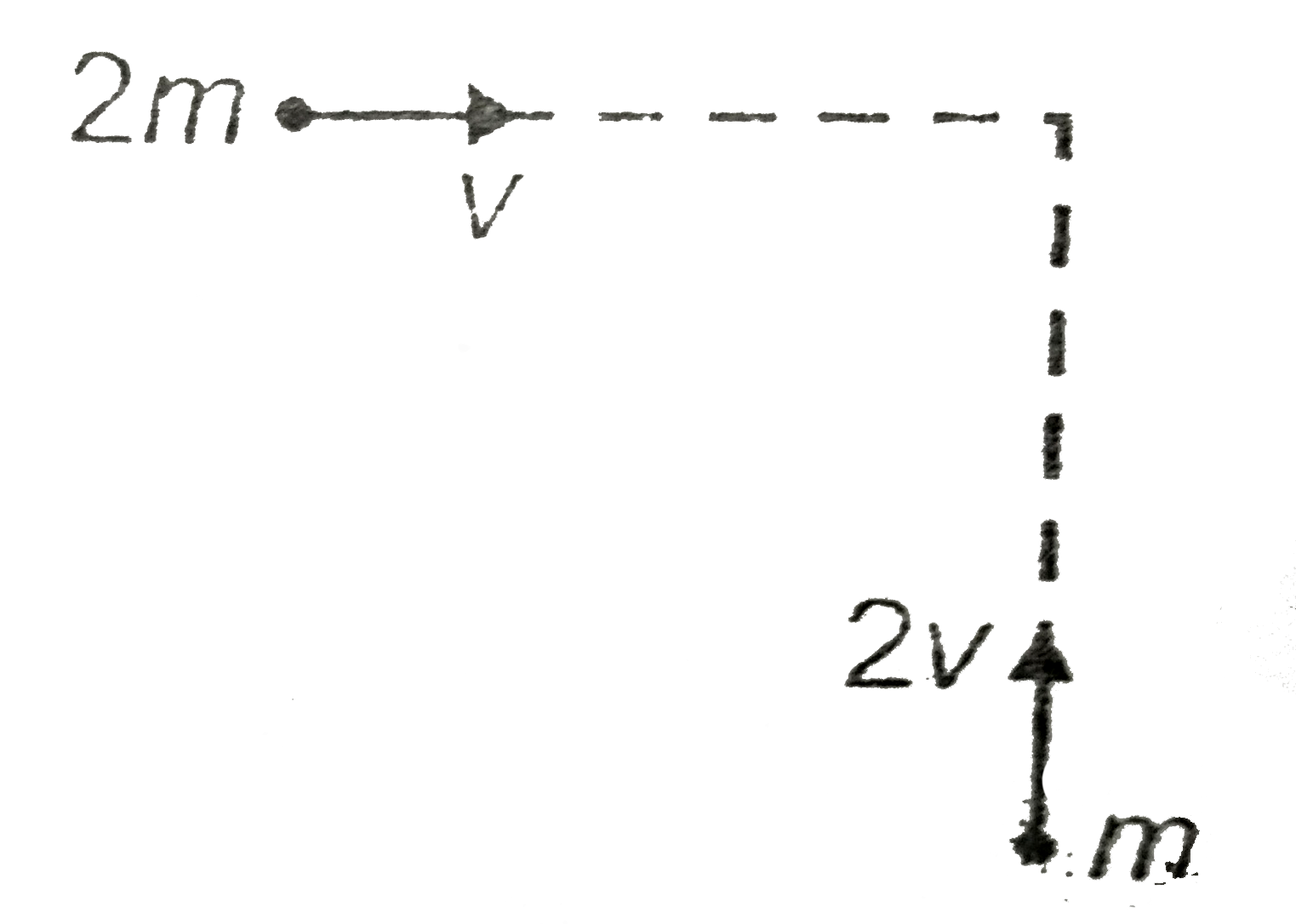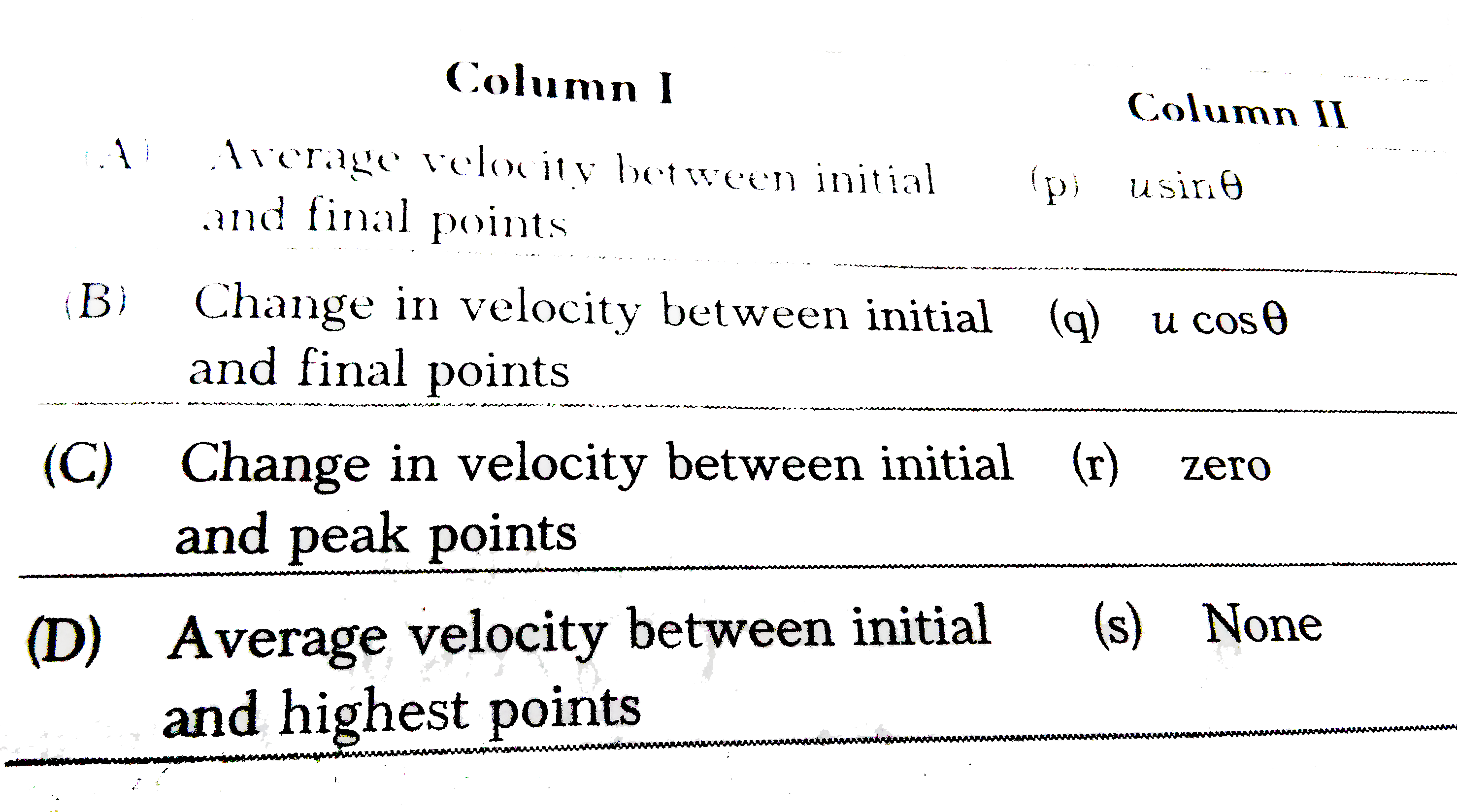A particle is projected from the ground with speed u at angle 60∘ from horizontal. It collides with a second particle of same mass moving with horizontal speed u in same direction at highest point of its trajectory. If collision is perfectly inelastic then find horizontal distance travelled by them after collision when they reached at ground
58u2g
3√38u2g
2√2u2g
3√24u2g
The correct Answer is:B
To solve the problem, we will follow these steps:
Step 1: Determine the components of the initial velocity
The particle is projected with speed u at an angle of 60∘ from the horizontal. We can find the horizontal and vertical components of the velocity:
- Horizontal component:
ux=ucos(60∘)=u⋅12=u2
- Vertical component:
uy=usin(60∘)=u⋅√32=u√32
Step 2: Calculate the time to reach the maximum height
The time taken to reach the maximum height can be calculated using the vertical component of the velocity and the acceleration due to gravity g:
At maximum height, the vertical velocity becomes zero. Using the formula:
vy=uy−gt
Setting vy=0:
0=u√32−gt⟹gt=u√32⟹t=u√32g
Step 3: Calculate the maximum height
The maximum height h can be calculated using the formula:
h=uyt−12gt2
Substituting t:
h=u√32⋅u√32g−12g(u√32g)2
Calculating the first term:
h=u2⋅34g−12g⋅3u24g2=3u24g−3u28g=6u2−3u28g=3u28g
Step 4: Find the horizontal distance traveled before collision
At the maximum height, the horizontal distance x traveled by the first particle is:
x=ux⋅t=u2⋅u√32g=u2√34g
Step 5: Determine the velocity after collision
Since the collision is perfectly inelastic, the two particles stick together. The total momentum before the collision is:
Total momentum=m⋅u+m⋅u2=mu+mu2=3mu2
The combined mass after the collision is 2m. Thus, the velocity v after the collision is:
v=Total momentumTotal mass=3mu22m=3u4
Step 6: Calculate the time to fall from maximum height to the ground
The time tf taken to fall from the maximum height h to the ground can be calculated using:
h=12gt2f⟹t2f=2hg⟹tf=√2hg=
⎷2⋅3u28gg=√3u24g2=u√32g
Step 7: Calculate the horizontal distance traveled after collision
The horizontal distance d traveled after the collision until they reach the ground is:
d=v⋅tf=3u4⋅u√32g=3u2√38g
Final Answer
The total horizontal distance traveled by the two particles after the collision until they reach the ground is:
Total distance=x+d=u2√34g+3u2√38g=2u2√38g+3u2√38g=5u2√38g
The particle is projected with speed u at an angle of 60∘ from the horizontal. We can find the horizontal and vertical components of the velocity:
ux=ucos(60∘)=u⋅12=u2
uy=usin(60∘)=u⋅√32=u√32
The time taken to reach the maximum height can be calculated using the vertical component of the velocity and the acceleration due to gravity g:
vy=uy−gt
Setting vy=0:
0=u√32−gt⟹gt=u√32⟹t=u√32g
The maximum height h can be calculated using the formula:
h=uyt−12gt2
Substituting t:
h=u√32⋅u√32g−12g(u√32g)2
Calculating the first term:
h=u2⋅34g−12g⋅3u24g2=3u24g−3u28g=6u2−3u28g=3u28g
At the maximum height, the horizontal distance x traveled by the first particle is:
x=ux⋅t=u2⋅u√32g=u2√34g
Since the collision is perfectly inelastic, the two particles stick together. The total momentum before the collision is:
Total momentum=m⋅u+m⋅u2=mu+mu2=3mu2
The combined mass after the collision is 2m. Thus, the velocity v after the collision is:
v=Total momentumTotal mass=3mu22m=3u4
The time tf taken to fall from the maximum height h to the ground can be calculated using:
h=12gt2f⟹t2f=2hg⟹tf=√2hg=
⎷2⋅3u28gg=√3u24g2=u√32g
The horizontal distance d traveled after the collision until they reach the ground is:
d=v⋅tf=3u4⋅u√32g=3u2√38g
The total horizontal distance traveled by the two particles after the collision until they reach the ground is:
Total distance=x+d=u2√34g+3u2√38g=2u2√38g+3u2√38g=5u2√38g
Topper's Solved these Questions
Similar Questions
Knowledge Check
A particle is projected from the ground with an initial speed v at an angle θ with horizontal. The average velocity of the particle between its point of projection and highest point of trajectory is [EAM2013]
AucosθBu2√1+cos2θCu2√1+2cos2θDu2√1+3cos2θ
A particle is projected from the ground with velocity u making an angle θ with the horizontal. At half of its maximum heights,
View SolutionA particle is projected with speed u at angle θ to the horizontal. Find the radius of curvature at highest point of its trajectory
View SolutionA ball is projected from the ground with speed u at an angle α with horizontal. It collides with a wall at a distance a from the point of projection and returns to its original position. Find the coefficient of restitution between the ball and the wall.
View SolutionA particle is thrown with a speed u at an angle θ with the horizontal. When the particle makes an angle ϕ with the horizontal. Its speed changes to v :
View SolutionA stone is projected with speed of 50ms−1 at an angle of 60∘ with the horizontal. The speed of the stone at highest point of trajectory is
View SolutionTwo particles of mass 2m and m moving with speed v and 2v respectively pependicular to each other collides perfectly inelastically, then

Find the angle with the horizontal to which the particles move after collision.
View SolutionA particle of mass m is projected from the ground with an initial speed u at an angle α. Find the magnitude of its angular momentum at the highest point of its trajector about the point of projection.
View Solution

